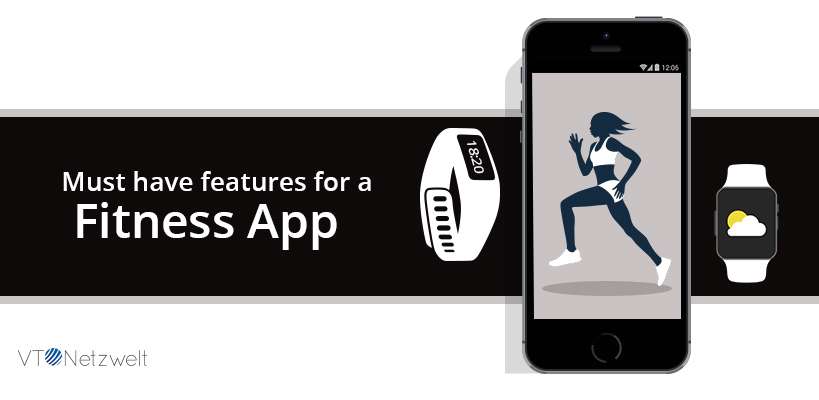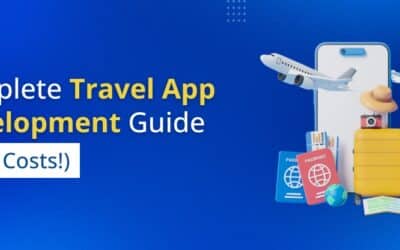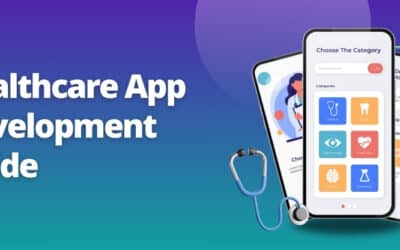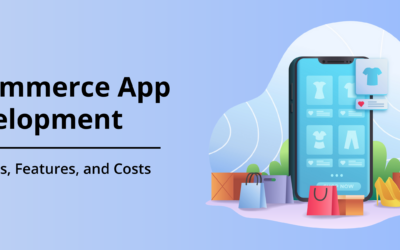Summary of the Article
Have a project in mind?
Schedule a CallMust have features for developing a fitness application
Summary of the Article
It is no news that most people are crazy about fitness in today’s world. Everyone is concerned about their health and fitness because of widespread consciousness that is raised about fitness.
People are ready to do anything to stay healthy and fit and they are sparing no expenses. A helpful addition to the fitness world is fitness apps that when installed help the users further their fitness quotient.
There are a lot of fitness apps available in the market both on Google Play Store and Apple App Store. It totally depends upon your fitness goals that which app you want to choose.
Fitness apps can be of various types, they can either be simple and measure things like the number of kilometers you’ve run to more complex functions such as calories consumed in a single day, etc. These apps keep a track of food eaten, suggest diet charts and even exercise routines.
Fitness App Development
Everyone is busy nowadays and these apps help you to stay fit. So, if you are an enterprise or a startup looking to get into the healthcare industry this is an ideal time to develop a fitness app.
For developing any application, you need to decide the ecosystem for which you want to get your app developed. There are only two dominating OS ruling the smartphone market –
- iOS
- Android
For developing health and fitness application, you can either hire experienced iOS developers and Android app developers or you can hire a software development company to get your app developed.
Some interesting facts about the Health & Fitness Industry
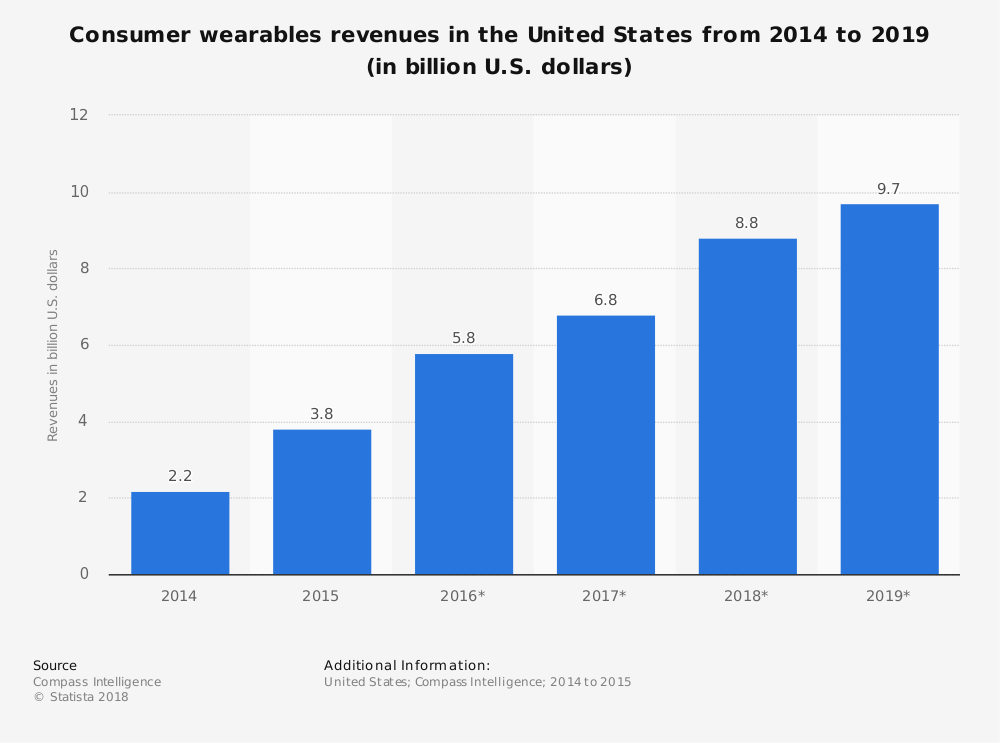
The chart above suggests revenues from wearables in billions of US Dollars, and as the forecast for 2019 suggests, wearables business will continue to rise.
According to Statista’s report, the fitness application which analyzes the fitness reports like running status or weight lifted is going to be most popular in coming days.
By 2021 the fitness market will show significant growth, so now it’s the right time for startups to get into the industry. If you’re already thinking about creating a fitness application, let’s have a look at what types of them you might build.
Different types of fitness apps
- Activity tracking apps
- Workout and exercise apps
- Nutrition apps
Activity tracking apps
Activity tracking apps are mostly for people who don’t go to the Gym or are not fond of physical activities, however, nonetheless, want to ensure that they move sufficiently.
Such type of application counts the number of steps and calories burn. With the help of GPS, they could track the distance walked.
Most interesting functions is sleep quality estimation and the smart alarm clock which wake up the user at some point in the REM sleep phase and making the person awake quickly without any problems.
Most of the apps which monitored the user activity can be paired with the wearable device.
Workout and exercise apps
Workout apps have broadest features on the list. As the name implies, they’re centered on workouts. Its foremost purpose is to reveal the user what physical exercise to do and provide an explanation for exactly the way to do them.
There are lots of examples of fitness apps, and their unique features.
However, Fitness applications are divided into 3 types:
- Personal training apps
- Logbook apps
- Workout apps that pair with devices
Let’s start with the first category
Personal training apps
The main idea right here is to provide an exercising complex that may be tailored to each consumer. Customers just need to select a stage of complexity and a set of physical activities they prefer.
Usually, a personal trainer at the gym makes sure people do exercises nicely, however with these applications user don’t need to pay for the health club anymore – 3D models, videos, or just specified descriptions give an explanation for how to carry out each exercise.
6 Week Training, FitnessBuilder Plus, and iWOD Fitness are a few of the most popular apps of this kind.
Logbook apps
Logbook apps are like a to-do listing and basically just store data about workouts. HeavySet, Fitbod, and Stacked are well-known examples of logbook apps. Preset libraries with sporting events and a huge preference for exercising workouts are available for the customers in these apps.
Workout apps that pair with devices
Workout apps are an excellent choice for those sports lovers who can’t consider an exercise without a fitness band or some other type of wearable device. All of the statistics that wearable gadgets accumulate straight away shows up on the display of the cell phone.
Nutrition apps
These application help user to control their weight by way of counting calories consumed and burned, controlling water stability, and inspiring healthful ingesting habits. They can also assist to track how much coffee they drink and how to hold body fat, weight, and percentage in control.
Setting personal goals is the main consciousness of such apps. If a person has a hard time sticking to healthy nutrients, the app will assist to create grocery buying lists, and even gather healthy food recipes!
A few of the best-rated applications of this type are HealthyOut, Calorie Counter, Food Dairy, and MyPlate Calories Tracker.
14 must-have features for the fitness app
-
Account creation
Accounts are vital due to the fact they allow customers to save the information and maintain their information if they change gadgets.
-
Adding personal info
The ability to add personal information is vital due to the fact the diet or workout programs for your app must be set according to a user’s age, weight, height, and other physical parameters. Calculating workouts based on personal statistics makes the workouts more individual and is usually favored by means of the user who are worried about health problems. Here are the forms of facts that your fitness app desires to collect:
- Age
- Gender
- Height
- Weight
Your application additionally must be satisfactory to use, so add profile photos to make it even more personalized. And don’t forget to offer measurements in both imperial units (pounds, ft) or metric units (kilos, meters). They should be optional, due to the fact your users might be used to the different system, in order that they won’t recognize feet, if they may be used to meters.
-
Pre-set exercise routines
This option is unique to workout apps. The primary problem with maximum workout apps is that the routines can’t be customized. We suggest making routines customization because it’s handier for users.
-
Setting targets
Fitness app lets the person set targets. Crossfit apps want to have objectives for workout routines, while activity tracking apps need to have targets for the range of steps or hours of sleep. While it comes to diet apps, objectives might be calorie limits or pounds lost. The target is that the user wants to stay inspired. The user ought to see clearly what they’re striving for.
-
Integrating with other services
The best and most handy way to sign up an account in an app is through social networks. With social logins, users can immediately see all their friends who use the same app and may begin publishing their results on social media. Firstly, this will increase motivation because the user can see their friends’ progress. Secondly, it brings extra users to an app once they see their friends’ achievements.
-
Configurable alerts and notifications for the user
Fitness app development requires full-size understanding as the user expects on them to deliver personalized reminder in the form of push notifications. Like e-commerce apps, push notifications are essential for these apps as they drive the health freaks to get going and burn some calories or eat a wholesome snack at a specific time for during the day.
-
Near real-time analytics over collected data
It will help the user to set the goal and the app will provide real-time analysis of the data it has collected from the user.
There are very few devices that provide interpretive analytics that can actually make people’s lives better. Successful fitness apps should be focused on the integration and analysis of data, and providing actionable feedback.
-
Gamification
Gamification is used to entertain and to inspire a person. The achievements which might be accomplished by video games are right but if it’s competing with other user is even more interesting. Let your user receives rewards, and examine results with their friends.
-
Activity tracking
As HealthKit and Google Fit come in handy, it can convert your app to utilize all sensors like accelerometers, gyroscopes, and compasses to track different activities like cycling, walking, swimming and even running activities.
-
Live streaming
This feature is optional, but it’s actually interesting. Live streaming permits users to broadcast their exercises and consult expert trainers online during the training process.
-
Integration with wearable devices or mobile device functions
Your app has the ability to connect with as many trackers as possible if you plan to assist wearables. You could use Apple’s HealthKit or Google Fit for storage and use distinctive wearable manufacturers’ APIs to connect devices to your app.
-
Geolocation
As all activity tracking apps are the game of maps, you must truly enforce geolocation into your app.
You can use maps of Apple, Google and there are numerous options to be able to permit your user to plan routes, report workouts, and track their current location.
Location of the user may be shared additionally on a different social media platform.
-
Food logging
No weight-reduction plan app can exist without meals logging so that you must implement this option. Diet apps should make it easy to log information, so the app will assist to create grocery buying lists, and even gather healthy food recipes.
-
Barcode scanner
Barcode scanning is a very useful function to make logging quicker and simpler. With barcode scanning, your users can get all of the necessary data like calories or ingredients by just scanning a barcode with your smartphone.
Summary
The fitness app scenario is a crowded one and the best way to succeed is to be one of a kind. Having these essential features in your fitness application can take your app a long way however you’ll want an expert iOS & Android development company to make sure that it is done well.
Hire an experienced Fitness app development company
At VT Netzwelt, we offer top-notch Android app development services & iOS app development services. We have an outstanding track document for having created flexible solutions for enterprise customers.
At VT Netzwelt, we offer top-notch Android app development services & iOS app development services. We have an outstanding track document for having created flexible solutions for enterprise customers.
Our expertise in building complex mobility solutions has made us the trusted partner of various leading companies across the globe.
iOS app development services
Proficient in iPhone app development, we offer custom-made solutions keeping in mind the design and development guidelines related to Apple ecosystem – iPhone, iPad, and Apple Watch.
Android app development services
Delivering innovation in Android app development, we help our clients unleash the power of Android, by building world-class Android application solutions.
Cross-platform app development solutions
VT Netzwelt offers a team of expert mobile app developers with extensive experience in Cross-Platform App development on leading platforms including React Native, Flutter.
Get in touch with us to hire dedicated Android app developers & iOS app developers for developing an awesome fitness application.
Frequently Asked Questions
Fitness app development entails designing and creating mobile applications focused on health and fitness. This involves incorporating features such as activity tracking, workout routines, nutrition tracking, goal setting, social sharing, and coaching functionalities. Additionally, ensuring user engagement, data security, and compatibility across various devices are key considerations in fitness app development.
Why should you hire an experienced fitness app development company?
What Are the 14 Must-Have Features for a Fitness App?
